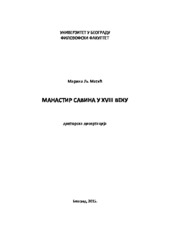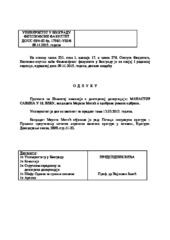Приказ основних података о дисертацији
Манастир Савина у XVIII веку
Savina monastery in the XVIII century
| dc.contributor.advisor | Brajović, Saša | |
| dc.contributor.other | Makuljević, Nenad | |
| dc.contributor.other | Rakić, Zoran D. | |
| dc.contributor.other | Stošić, Ljiljana | |
| dc.creator | Matić, Marina Lj. | |
| dc.date.accessioned | 2020-07-03T10:04:59Z | |
| dc.date.available | 2020-07-03T10:04:59Z | |
| dc.date.issued | 2015-12-15 | |
| dc.identifier.uri | https://nardus.mpn.gov.rs/handle/123456789/4265 | |
| dc.identifier.uri | http://eteze.bg.ac.rs/application/showtheses?thesesId=2326 | |
| dc.identifier.uri | https://fedorabg.bg.ac.rs/fedora/get/o:10248/bdef:Content/download | |
| dc.identifier.uri | http://vbs.rs/scripts/cobiss?command=DISPLAY&base=70036&RID=47546127 | |
| dc.description.abstract | Истраживачким радом на теми „Манастир Савина у XVIII веку“ желели смо, након вишедеценијске паузе и досадашњих несинтетичких истраживања, да дамо свеобухватни осврт на важну улогу која је припала манастиру Савина у очувању православног идентитета у Боки Которској током XVIII века. У одсуству црквене организације и епископског поглаварства на подручју Далмације и Боке у XVIII веку, стожери заштите интереса православних постају манастири са њиховим предузимљивим и пожртвованим братствима. У околностима млетачке власти и конфесионалне диферентности, братство Савине, након смрти једног херцеговачког епископа (Саватија Љубибратића) и протеривања другог (Стефана Љубибратића), почиње да активно учествује у свим верско-политичким догађајима. Неколико савинских пострижника биће и кандидати за епископа далматинско-бококоторског. Стратегија и деловање савинског братства били су усмерени, нарочито од половине XVIII века, и ка прикупљању средстава за изградњу Велике цркве. Велики удео у остваривању тог циља имаће прилози скупљени у Русији, али и у многим другим крајевима, као и економија самог манастира, вешто вођена у оквирима постојећих могућности. Искористивши повољне друштвено-политичке околности, одлучније упливе Русије на Балкан, Руско-турски рат 1768-1774, велика исељавања становништва из Далмације и Боке седамдесетих година XVIII века, општу економску кризу Републике, те отуд њену извесну склоност ка попуштању и толеранцији према православнима, савинци коначно успевају да добију одобрење млетачких власти за градњу Велике цркве. У њу ће бити уткан читав сплет ангажованости и циљева, кроз које се може предочити свеобухватна друштвена историја овог подручја. Добивши одобрење за своју вишедеценијску тежњу да се подигне нова црква, савинци су тај храм програмски осмислили као особени уметнички амалгам. Наше истраживање је показало да су при том били плански наслоњени на актуелне барокне моделе у српским духовним центрима северно од Саве и Дунава, са којима су имали сталне контакте. Посебну улогу имао је јеромонах савински Инокентије Дабовић, касније и архимандрит, који је више година провео у фрушкогорским манастирима. Тако савинска Велика црква оличава инвентивну архитектонску целину у чије су барокно ткиво вешто уплетени локална традиција, историзам и особености текућег верско-културног модела, коначно дајући иновативну и идејно ангажовану синтезу структуре нове савинске цркве. Идејни концепт Велике цркве доследно је употпуњен ликовним програмом у унутрашњости. Ликовни програм осмишљен је у духу нових барокних тенденција, у које је хармонично уткана традиционалност (и сама легитимни чинилац барокне културе). Такав приступ био је неопходан да би се повезао тадашњи културни и уметнички модел са датим околностима, потребама, циљевима, као и са ефектима које је требало постићи у локалној средини. У савинској ликовној нарацији вешто се преплићу сакрална симболика, ангажована иконографија и месно предање, чије је препознавање тамо имало парадигматски значај. У целини, савинска Велика црква је први пример православног храма у Боки Которској са доследно спроведеним барокним концептом и у архитектонском и у ликовном обликовању. У предоченом идејном склопу, посебно је препозната и прослављана чудотворна икона Богородице Савинске, својствено сложености и механизмима ангажованости у епохи барока. Спој изразитог визуалног ефекта са вишезначним улогама, пре свега својеврсног паладијума, које је ова чудотворица остваривала у оквиру локалне заједнице, представљао је и тачку ослонца култне и интимне побожности православних овог подручја. До овакве слојевите слике о манастиру Савина, и о његовој утканости у живот, делатности, циљеве, борбе, наде и веру локалне заједнице, дошли смо ослањањем на огромну архивску грађу. Њен већи део, и досад готово потпуно неистражен, чини млетачки архив из XVIII века. Коришћењем овог првокласног материјала, манастир Савина сагледан је у потпуно новом контексту. Указује се пред нама као веома важно средиште не само за православне у Боки, већ и у целини српске цркве у XVIII веку. Такав непосредни увид у изворни архивски материјал омогућио нам је да отклонимо више крупних нетачности које су се дуже од века преносиле у научној литератури, као и да разрешимо неке забуне и недоумице у друштвеним, црквено-историјским и ликовним тумачењима манастира Савина. Кроз иконолошка истраживања и морфолошко-феноменолошке карактеристике, тежили смо да проникнемо у изворни смисао програмског обликовања Велике савинске цркве, жижне тачке наших интересовања. Разуме се, неопходан је био и увид у контекст, време, простор, друштвено-политичке околности и предања, који се неоспорно сажимају у структури и ликовној идеји споменика. | sr |
| dc.description.abstract | With our study of the topic “Savina Monastery in the XVIII century”, we wanted to, after several decades of pause and previous non-synthetic research, give a comprehensive review of the important role of Savina Monastery in preserving Orthodox Christian identity in Boka Kotorska during the XVIII century. In the absence of a church organization and episcopal leader in the area of Dalmatia and Boka in the XVIII century, monasteries and their entrepreneurial and hard-working fraternities became the strongholds for protecting the interests of Orthodox Christians. Under Venetian rule and amidst confessional differentiation, the fraternity of Savina, following the death of one Herzegovina episcope (Savatije Ljubibratić) and banishment of another (Stefan Ljubibratić), the Monastery became an active participant of all religious and political events. Furthermore, several monks of Savina were candidates for the episcope of Dalmatia and Boka Kotorska. The strategy and activities of the Savina fraternity were directed, especially since mid-XVIII century, towards collecting financial means for the construction of the Big Church. Contributions collected in Russia, as well as many other lands, have a large part in the realization of that objective, along with the economy of the monastery itself, skillfully managed within the limits of existing possibilities. Making use of favorable social and political circumstances, more reluctant involvement of Russia in the Balkans, the 1768-1774 Russian-Turkish war, big migrations of the population from Dalmatia and Boka in the 1770s, general economic crisis of the Republic, resulting in a certain easiness and tolerance towards Orthodox Christians, the Savina fraternity finally managed to receive approval from the Venetian authorities for the construction of the Big Church. An entire system of engagements and objectives was embedded in it, presenting a comprehensive social history of this area. After having received the approval for their decades-long aspiration towards building a new church, the Savina fraternity designed the temple as a unique artistic amalgam. Our research has showed that the design was made looking up to the actual Baroque models in Serbian spiritual centers north of the Sava and the Danube, which they were constantly in contact with. Hieromonk of Savina Inokentije Dabović, later archimandrite, who spent several years in the monasteries of Fruška Gora, had a special role in it. Thus the Savina Big Church impersonates an inventive architectural whole, with local tradition, history and features of the contemporary religious and cultural model skillfully interwoven into its Baroque tissue, finally giving an innovative and engaged synthesis of the structure of the new Savina Church. The idea of the Big Church was consistently completed with the artistic program in its interior. The program was designed in the spirit of new Baroque tendencies, with harmoniously embedded traditionalism (also a legitimate element of the Baroque culture). Such an approach was necessary in order to connect the then cultural and artistic model with the given circumstances, needs, objectives, as well as the effects necessary to be achieved in the local environment. Sacral symbolism, engaged iconography and local legends, whose recognition had a paradigmatic importance, are skillfully interwoven in the Savina artistic narration. As a whole, the Savina Big Church is the first example of an Orthodox Christian temple in Boka Kotorska, with the Baroque concept consistently implemented both in the architectural and the artistic form. In the presented conceptual frame, especially recognized and celebrated was the miraculous icon of Virgin Mary of Savina, typical for the complexity and mechanisms of engagements in the Baroque era. The connection of an expressive visual effect with multilayered roles, mainly a kind of a palladium, which this miraculous icon achieved within the local community, represented the anchor point of the cult and intimate religiousness of the Orthodox Christians in this area. Leaning upon a voluminous archive material led us to such a multilayered image of the Savina Monastery, its embeddedness into the life, activities, objectives, battles, hopes and faith of the local community. The major part of that material, almost completely unexplored up to now, is the XVIII century Venetian archive. The use of this first-class material made it possible to perceive Savina Monastery in a completely new context. It comes before us as a very important center for Orthodox Christians in Boka, as well as for all Serbian churches in the XVIII century. Such a direct insight into the original archive material enabled us to correct several major errors present in the scientific literature for more than a century, as well as to resolve some confusions and doubts in the social, ecclesiastical, historical and artistic interpretations of Savina Monastery. Through iconological research and morphological and phenomenological features, we tended to reach the original meaning of the conceptual shaping of the Savina Big Church, the major point of our interest. Certainly, it was also necessary to have insight into the context, time, space, social and political circumstances and legends, undoubtedly summed up in the structure and artistic idea of this monument. | en |
| dc.format | application/pdf | |
| dc.language | sr | |
| dc.publisher | Универзитет у Београду, Филозофски факултет | sr |
| dc.rights | openAccess | en |
| dc.rights.uri | https://creativecommons.org/licenses/by-nc-nd/4.0/ | |
| dc.source | Универзитет у Београду | sr |
| dc.subject | Бока Которска | sr |
| dc.subject | Boka Kotorska | en |
| dc.subject | манастир Савина | sr |
| dc.subject | XVIII век | sr |
| dc.subject | млетачка власт | sr |
| dc.subject | православни идентитет | sr |
| dc.subject | барок | sr |
| dc.subject | Велика црква Успења Богородичиног | sr |
| dc.subject | Богородица Савинска | sr |
| dc.subject | хијеротопија | sr |
| dc.subject | Savina Monastery | en |
| dc.subject | XVIII century | en |
| dc.subject | Venetian rule | en |
| dc.subject | Orthodox Christian identity | en |
| dc.subject | Baroque | en |
| dc.subject | Big Church of the Assumption of Virgin Mary | en |
| dc.subject | Virgin Mary of Savina | en |
| dc.subject | hierotopy | en |
| dc.title | Манастир Савина у XVIII веку | sr |
| dc.title | Savina monastery in the XVIII century | en |
| dc.type | doctoralThesis | en |
| dc.rights.license | BY-NC-ND | |
| dcterms.abstract | Брајовић, Саша; Макуљевић, Ненад; Ракић, Зоран Д.; Стошић, Љиљана; Матић, Марина Љ.; Manastir Savina u XVIII veku; | |
| dc.identifier.fulltext | https://nardus.mpn.gov.rs/bitstream/id/27760/Disertacija86.pdf | |
| dc.identifier.fulltext | https://nardus.mpn.gov.rs/bitstream/id/27761/Marina_Matic_referat_FZF-28089.pdf | |
| dc.identifier.fulltext | http://nardus.mpn.gov.rs/bitstream/id/27760/Disertacija86.pdf | |
| dc.identifier.fulltext | http://nardus.mpn.gov.rs/bitstream/id/27761/Marina_Matic_referat_FZF-28089.pdf | |
| dc.identifier.rcub | https://hdl.handle.net/21.15107/rcub_nardus_4265 |



